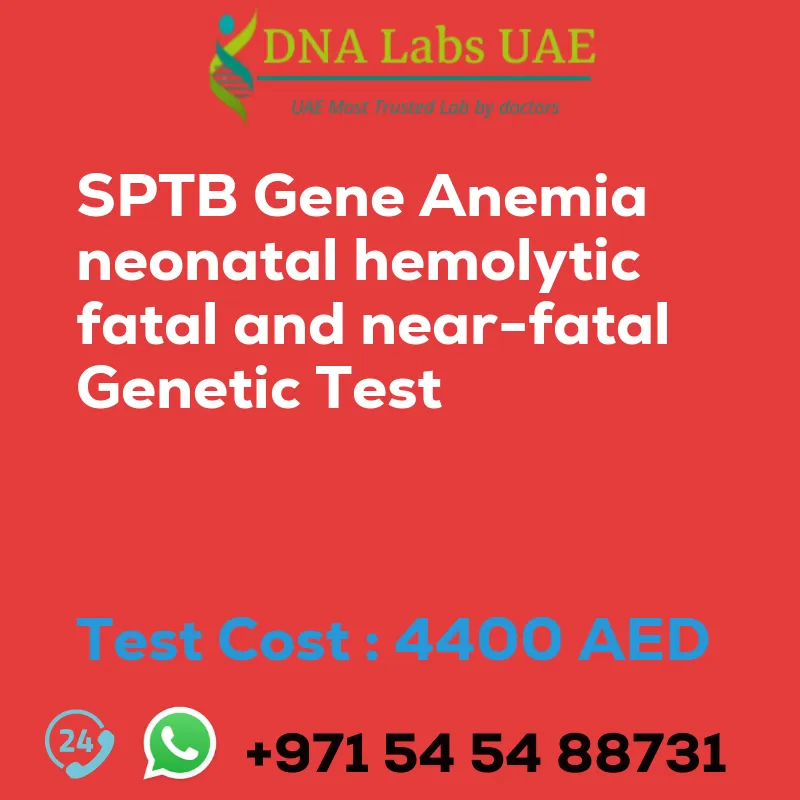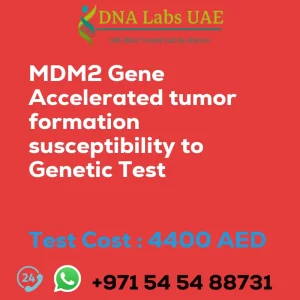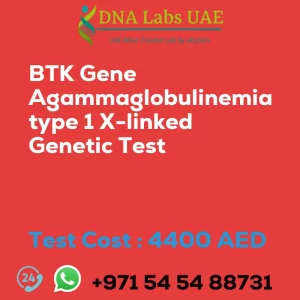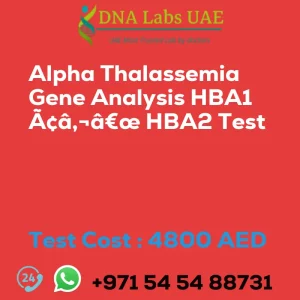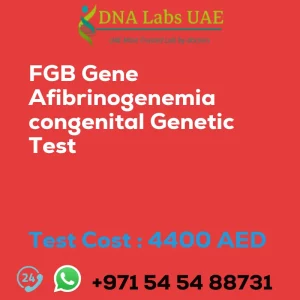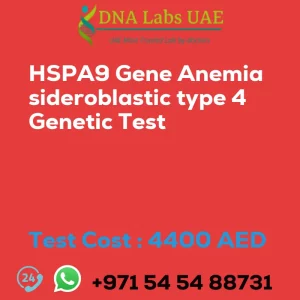SPTB Gene Anemia Neonatal Hemolytic Fatal and Near-Fatal Genetic Test
Welcome to DNA Labs UAE’s blog post on the SPTB Gene Anemia neonatal hemolytic fatal and near-fatal genetic test. In this blog, we will discuss the symptoms, diagnosis, and cost of this genetic test.
Test Details
The SPTB gene is associated with a condition called neonatal hemolytic anemia. This genetic disorder affects the production and function of a protein called spectrin, which is important for maintaining the shape and stability of red blood cells. Neonatal hemolytic anemia can be a life-threatening condition, leading to the premature destruction of red blood cells and a shortage of healthy red blood cells in the body.
Symptoms of neonatal hemolytic anemia can include pale skin, jaundice (yellowing of the skin and eyes), an enlarged spleen, and a rapid heartbeat. In severe cases, it can be fatal or result in long-term complications.
Test Name: SPTB Gene Anemia Neonatal Hemolytic Fatal and Near-Fatal Genetic Test
Components: Blood or Extracted DNA or One drop Blood on FTA Card
Price: 4400.0 AED
Sample Condition: Blood or Extracted DNA or One drop Blood on FTA Card
Report Delivery: 3 to 4 Weeks
Method: NGS Technology
Test type: Hematology
Doctor: Hematologist
Test Department: Genetics
Pre Test Information: Clinical History of Patient who is going for SPTB Gene Anemia, neonatal hemolytic, fatal and near-fatal NGS Genetic DNA Test. A Genetic Counselling session to draw a pedigree chart of family members affected with SPTB Gene Anemia, neonatal hemolytic, fatal and near-fatal NGS Genetic DNA Test gene SPTB
NGS Genetic Testing
NGS (Next Generation Sequencing) genetic testing is a type of genetic test that can analyze multiple genes simultaneously. In the case of neonatal hemolytic anemia associated with the SPTB gene, NGS testing can identify specific mutations or changes in the SPTB gene that may be causing the condition.
This genetic testing can help with the diagnosis of neonatal hemolytic anemia and provide information about the specific genetic changes involved. This information can be useful for understanding the prognosis of the condition, guiding treatment decisions, and providing genetic counseling to affected individuals and their families.
It is important to note that NGS genetic testing is a complex and specialized test that should be performed by trained professionals in a certified laboratory. The results of the test should be interpreted in the context of the individual’s clinical presentation and family history, and in consultation with a healthcare provider or genetic counselor.
Conclusion
The SPTB Gene Anemia neonatal hemolytic fatal and near-fatal genetic test is an important tool for diagnosing and understanding neonatal hemolytic anemia. With its ability to analyze multiple genes simultaneously, NGS genetic testing provides valuable information about specific genetic changes involved in this condition. This information can help guide treatment decisions, provide genetic counseling, and improve patient outcomes.
For more information about the SPTB Gene Anemia neonatal hemolytic fatal and near-fatal genetic test, please contact DNA Labs UAE. We are a certified laboratory with trained professionals who can perform this specialized test.
| Test Name | SPTB Gene Anemia neonatal hemolytic fatal and near-fatal Genetic Test |
|---|---|
| Components | |
| Price | 4400.0 AED |
| Sample Condition | Blood or Extracted DNA or One drop Blood on FTA Card |
| Report Delivery | 3 to 4 Weeks |
| Method | NGS Technology |
| Test type | Hematology |
| Doctor | Hematologist |
| Test Department: | Genetics |
| Pre Test Information | Clinical History of Patient who is going for SPTB Gene Anemia, neonatal hemolytic, fatal and near-fatal NGS Genetic DNA Test. A Genetic Counselling session to draw a pedigree chart of family members affected with SPTB Gene Anemia, neonatal hemolytic, fatal and near-fatal NGS Genetic DNA Test gene SPTB |
| Test Details |
The SPTB gene is associated with a condition called neonatal hemolytic anemia. This is a genetic disorder that affects the production and function of a protein called spectrin, which is important for maintaining the shape and stability of red blood cells. Neonatal hemolytic anemia can be a life-threatening condition, as it leads to the premature destruction of red blood cells and a shortage of healthy red blood cells in the body. Symptoms can include pale skin, jaundice (yellowing of the skin and eyes), an enlarged spleen, and a rapid heartbeat. In severe cases, it can be fatal or result in long-term complications. NGS (Next Generation Sequencing) genetic testing is a type of genetic test that can be used to analyze multiple genes simultaneously. In the case of neonatal hemolytic anemia associated with the SPTB gene, NGS testing can identify specific mutations or changes in the SPTB gene that may be causing the condition. This genetic testing can help with the diagnosis of neonatal hemolytic anemia and provide information about the specific genetic changes involved. This information can be useful for understanding the prognosis of the condition, guiding treatment decisions, and providing genetic counseling to affected individuals and their families. It is important to note that NGS genetic testing is a complex and specialized test that should be performed by trained professionals in a certified laboratory. The results of the test should be interpreted in the context of the individual’s clinical presentation and family history, and in consultation with a healthcare provider or genetic counselor. |

